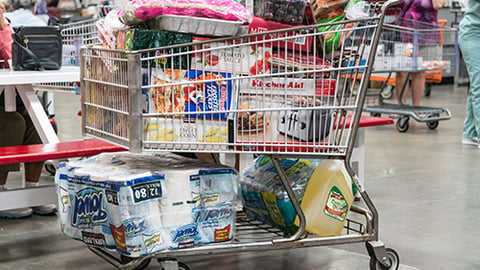NRF: Tariff Anxiety Hinders Economic Forecasts
WASHINGTON, D.C. — Even more than half way into 2025, it is difficult to predict the impact that new tariffs and other government policies will have on the U.S. economy, according to National Retail Federation (NRF) Chief Economist Jack Kleinhenz.
"This year began with high expectations for the strength of the U.S. economy," Kleinhenz said, citing the strong 2.8% year-over-year growth in gross domestic product (GDP) seen in 2024 that was led by consumer spending aided helped by business and government spending. "Since then, anxiety and confusion have taken center stage in the economy and financial markets as uncertainty over public policy has intensified. It was difficult to judge how policy changes would impact the economy in early 2025 and it remains so now.
[Read more: Latest Tariff News Sparks Concern Among Retailer Groups]
"Economic fundamentals appear solid at this juncture, but uncertainty is pervasive," Kleinhenz continued. "There are many crosscurrents surrounding tariffs, immigration and deregulation, and everyone is sorting through what the tariff rates are going to be, how they will impact inflation for retail products and, importantly, how long they will be in place."
In the July edition of NRF's Monthly Economic Review, he noted that despite uncertainty about the future, "economic growth is holding up relatively well" so far in 2025.
Although GDP fell at an annual rate of 0.5% during the first quarter of the year, this was largely due to a surge in imports prompted by tariff announcements. In contrast, private final sales to domestic purchases, which help measure consumer and business spending were up 1.9% on the year. This was down from 2.9% during the previous quarter but continued strength in private sector demand and that "the slowdown has been less than feared," according to the report.
By the Numbers
Per the Personal Consumption Expenditures Price Index, year-over-year inflation saw a slight increase to 2.3% in May, up from 3.1% in April. Unadjusted for inflation, personal income and consumer spending were both up 4.5% in May.
Core retail sales as defined by NRF (based on Census Bureau data and excluding automobile dealers, gas stations and restaurants) rose 3.9% year over year in May and for the five months of the year.
The labor market is beating expectations, with employers adding 147,000 jobs in June, slightly above the monthly average of 46,000 jobs per month over the past year, while the unemployment rate held fairly steady at 4.1%. Additionally, job openings increased to 7.8 million in June, "indicating continued demand for workers" and exceeding the 7 million unemployed people.
Although tariffs have yet to be clearly seen in prices, "if the large increases in tariffs announced earlier this year take effect and are sustained, they will infiltrate consumer prices, causing a downshift in spending that is likely to spill over into the labor market later in the year with higher unemployment," Kleinhenz said.
He added that the Federal Reserve is "quite unlikely" to cut interest rates in July but could be on track to do so in the fall. Fed officials are reportedly closely watching the "inflation psychology" of consumers, including how expectations about future inflation influence their current spending and decisions, and whether they are influenced by short-term price increases.
According to an Economic Policy Uncertainty Index developed by economists at Stanford and Northwestern, uncertainty has fallen by half since April, when it reached the highest point since the pandemic. While the signing of the One Big Beautiful Bill Act has "many moving parts" that "could greatly alter the economic outlook" depending on reactions from businesses and consumers, it also "meaningfully reduces fiscal policy uncertainty."
Headquartered in Washington, D.C., NRF advocates for the people, brands, policies and ideas that help retail succeed. Retail is the nation's largest private-sector employer, contributing $5.3 trillion to annual GDP and supporting more than one in four U.S. jobs — 55 million working Americans.




